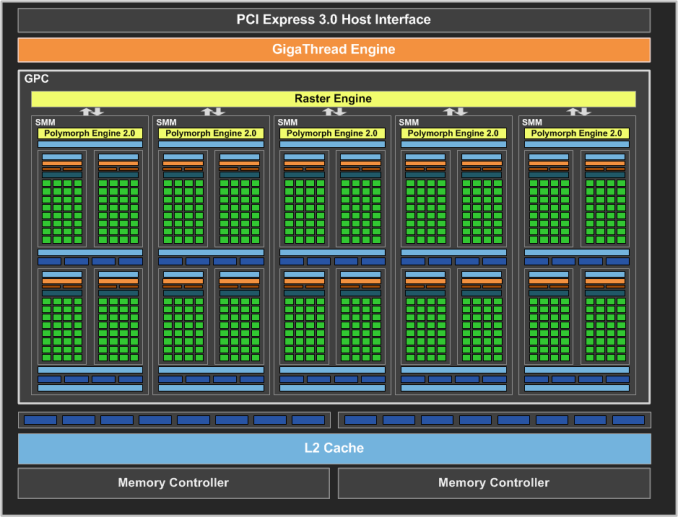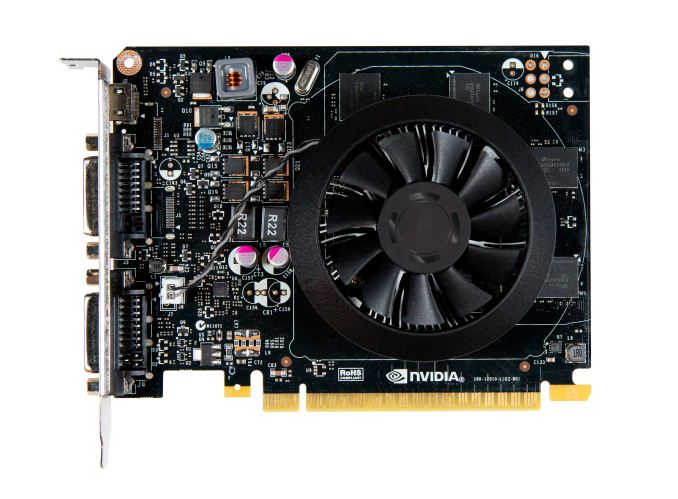The NVIDIA GeForce GTX 750 Ti and GTX 750 Review: Maxwell Makes Its Move
by Ryan Smith & Ganesh T S on February 18, 2014 9:00 AM ESTFinal Words
Bringing this review to a close, NVIDIA’s latest product launch has given us quite a bit to digest. Not only are we looking at NVIDIA’s latest products for the high volume mainstream desktop video card market, but we’re doing so through the glasses of a new generation of GPUs. With the GeForce GTX 750 series we are seeing our first look at what the next generation of GPUs will hold for NVIDIA, and if these cards are an accurate indication of what’s to follow then we’re being setup for quite an interesting time.
Starting from an architectural point of view, it’s clear from the very start that Maxwell is both a refresh of the Kepler architecture and at the same time oh so much more. I think from a feature perspective it’s going to be difficult not to be a bit disappointed that NVIDIA hasn’t pushed the envelope here in some manner, leaving us with a part that as far as features go is distinctly Kepler. Complete support for Direct3D 11.1 and 11.2, though not essential, would have been nice to have so that 11.2 could be the standard for new video cards in 2014. Otherwise I’ll fully admit I don’t know what else to expect of Maxwell – the lack of a new Direct3D standard leaves this as something of a wildcard – but it means that there isn’t a real marquee feature for the architecture to evaluate and marvel at.
On the other hand, the lack of a significant feature changes means that it’s much easier to evaluate Maxwell next to Kepler in the area where NVIDIA did focus: efficiency. This goes for power efficiency resource/compute efficiency, and space efficiency. Utilizing a number of techniques NVIDIA set out to double their performance per watt versus Kepler – a design that was already power efficient by desktop GPU standards – and it’s safe to say that they have accomplished this. With a higher resource efficiency giving NVIDIA additional performance with less hardware, and power optimizations bringing that power consumption down by dozens of watts, NVIDIA has done what in previous generations would have taken a die shrink. The tradeoff is that NVIDIA doesn’t have that die shrink, so die sizes grow in the process, but even then the fact that they packed so much more hardware into GM107 for only a moderate increase in die size is definitely remarkable from an engineering perspective.
Efficiency aside, Maxwell’s architecture is something of an oddity at first, but given NVIDIA’s efficiency gains it’s difficult to argue with the outcome. The partitioning of the SMM means that we have partitions that feel a lot like GF100 SMs, which has NVIDIA going backwards in a sense due to the fact that significant resource sharing was something that first became big with Kepler. But perhaps that was the right move all along, as evidenced by what NVIDIA has achieved. On the other hand the upgrade of the compute feature set to GK110 levels is good news all around. The increased efficiency it affords improves performance alongside the other IPC improvements NVIDIA has worked in, plus it means that some of GK110’s more exotic features such as dynamic parallelism and HyperQ are now a baseline feature. Furthermore the reduction in register pressure and memory pressure all around should be a welcome development; compared to GK107 there are now more registers per thread, more registers per CUDA core, more shared memory per CUDA core, and a lot more L2 cache per GPU. All of which should help to alleviate memory related stalls, especially as NVIDIA is staying on the 128-bit bus.
With that in mind, this brings us to the cards themselves. By doubling their performance-per-watt NVIDIA has significantly shifted their performance both with respect to their own product lineup and AMD’s lineup. The fact that the GTX 750 Ti is nearly 2x as fast as the GTX 650 is a significant victory for NVIDIA, and the fact that it’s nearly 3x faster than the GT 640 – officially NVIDIA’s fastest 600 series card without a PCIe power plug requirement – completely changes the sub-75W market. NVIDIA wants to leverage GM107 and the GTX 750 series to capture this market for HTPC use and OEM system upgrades alike, and they’re in a very good position to do so. Plus it goes without saying that compared to last-generation cards such as the GeForce GTX 550 Ti, NVIDIA has finally doubled their performance (and halved their power consumption!), for existing NVIDIA customers looking for a significant upgrade from older GF106/GF116 cards.
But on a competitive basis things are not so solidly in NVIDIA’s favor. NVIDIA does not always attempt to compete with AMD on a price/performance basis in the mainstream market, as their brand and retail presence gives them something they can bank on even when they don’t have the performance advantage. In this case NVIDIA has purposely chosen to forgo chasing AMD for the price/performance lead, and as such for the price the GeForce GTX 750 cards are the weaker products. Radeon R7 265 holds a particularly large 19% lead over GTX 750 Ti, and in fact wins at every single benchmark. Similarly, Radeon R7 260X averages a 10% lead over GTX 750, and it does so while having 2GB of VRAM to GTX 750’s 1GB.
On a pure price/performance basis, the GTX 750 series is not competitive. If you’re in the sub-$150 market and looking solely at performance, the Radeon R7 260 series will be the way to go. But this requires forgoing NVIDIA’s ecosystem and their power efficiency advantage; if either of those matter to you, then the lower performance of the NVIDIA cards will be justified by their other advantages. With that said however, we will throw in an escape clause: NVIDIA has hard availability today, while AMD’s Radeon R7 265 cards are still not due for about another 2 weeks. Furthermore it’s not at all clear if retailers will hold to their $149 MSRP due to insane demand from cryptocoin miners; if that happens then NVIDIA’s competition is diminished or removed entirely, and NVIDIA wins on price/performance by default.
Wrapping things up, as excited as we get and as focused as we are on desktop cards, it’s hard not to view this launch as a preview of things to come. With laptop sales already exceeding desktop sales, it’s a foregone conclusion that NVIDIA will move more GM107 based video cards in mobile products than they will in desktops. With GK107 already being very successful in that space and GM107 doubling NVIDIA’s performance-per-watt – and thereby doubling their performance in those power-constrained devices – it means that GM107 is going to be an even greater asset in the mobile arena. To that end it will be very interesting to see what happens once NVIDIA starts releasing the obligatory mobile variants of the GTX 750 series, as what we’ve seen today tells us that we could be in for a very welcome jump in mobile performance.












177 Comments
View All Comments
dylan522p - Tuesday, February 18, 2014 - link
They are waiting for 20nm for the entire 800 series .MugatoPdub - Tuesday, February 18, 2014 - link
Interestingly, it seems Nvidia has simply followed Intel in the "mobile first" market race, it is starting to feel as if the enthusiast will be left in the dust within the next few years =(Krysto - Tuesday, February 18, 2014 - link
Not likely, thanks to the boom in VR that we'll be seeing, which at 4k and 120fps games, will require 16x the performance we get now for games, just to play the same games, in a few years.So if anything, Nvidia should be making GPU's at the high-end that are a level or two ABOVE Titan (think 20-30 TF GPUs in 2015).
A5 - Tuesday, February 18, 2014 - link
They probably will? I'm guessing we won't see stuff below the top end (or SLI) targeted at 4K until late 2015/spring 2016, though.madmilk - Tuesday, February 18, 2014 - link
I doubt enthusiasts will be left behind, simply because HPC users will demand a 225W Tesla card. That in turn can easily sold as a 250W enthusiast card, perhaps under the Titan line.Mondozai - Wednesday, February 19, 2014 - link
Also, Nvidias desktop business is contributing to their profits and is seeing revenue growth. Their Tegra business revenue is falling almost 50% year over year.The desktop high-end GPU market will grow in good health for years to come. Their discrete laptop GPUs, however, will face doom in a relativeley short period of time as integrated GPUs performance rises to a level when most people are satisfied. Laptops specifically for gaming continues to be an unsignificant market.
jkauff - Tuesday, February 18, 2014 - link
madVR NNEDI3 uses OpenCL, and works fine on Intel and AMD boards. NVIDIA OpenCL support has been broken for the last couple of driver iterations. Please use your influence with the NVIDIA developers to get this fixed in the next driver release.IKeelU - Tuesday, February 18, 2014 - link
ugh, cryptocointexasti89 - Tuesday, February 18, 2014 - link
Wow! .. Substantially faster than 260x and consuming less than 60w using same process node. Really impressive. I can't wait to see how Maxwell arch performance & power scale at 20nm. I'm really convinced now that AMD GCN is not as efficient as many reviewers think. AMD will very likely have a hard time in this round.g101 - Tuesday, February 18, 2014 - link
*slower...Almost always slower than the 260x.... , all for power savings in the range of 5-10%...How...exciting?You should try reading the actual words that have been written in the article.